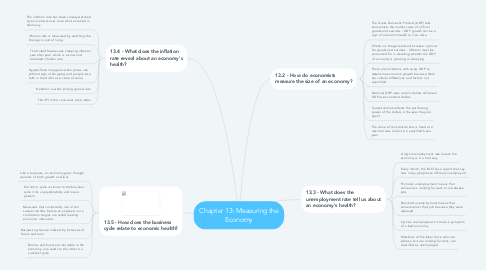Chapter 13: Measuring the Economy
by Maxwell Evenson

1. 13.4 - What does the inflation rate reveal about an economy's health?
1.1. The inflation rate has been closely watched by economists ever since what occurred in Germany
1.2. Inflation rate is measured by watching the change in cost of living
1.3. The United States sees creeping inflation year after year, which is a slow and tolerated inflation rate
1.4. Hyperinflation happens when prices rise without sign of stopping and people lose faith in the dollar as a store of value
1.5. Deflation is when pricing goes down
1.6. The CPI is the consumer price index
2. 13.5 - How does the business cycle relate to economic health?
2.1. Like a business, an economy goes through periods of both growth and loss
2.2. Economic cycle is similar to the business cycle in its unpredictability and loose pattern
2.3. Measures that consistently rise or fall several months before an expansion or a contraction begins are called leading economic indicators
2.4. Business cycles are marked by instances of boom and bust
2.5. Booms and busts are inevitable in the economy, one leads to the other in a constant cycle
3. 13.2 - How do economists measure the size of an economy?
3.1. The Gross Domestic Product (GDP) tells economists the market value of all final goods and services - GDP growth can be a sign of economic health or vice versa
3.2. Inflation is the generalized increase in prices for goods and services - Inflation must be accounted for in deciding whether the GDP of a country is growing or decaying
3.3. There are limitations with using GDP to determine economic growth because there are cultural differences and factors not quantified
3.4. Nominal GDP uses current dollars while real GDP uses constant dollars
3.5. Current dollars reflects the purchasing power of the dollars in the year they are spent
3.6. The value of constant dollars is fixed at a rate that was current in a specified base year
4. 13.3 - What does the unemployment rate tell us about an economy's health?
4.1. A high unemployment rate means the economy is in a bad way
4.2. Every month, the BLS files a report that say how many people are officially unemployed
4.3. Frictional unemployment means that someone is looking for work or is between jobs
4.4. Structural unemployment means that someone lost their job because they were replaced
4.5. Cyclical unemployment is more a symptom of a bad economy
4.6. Members of the labor force who are jobless, but are looking for work, are classified as unemployed


